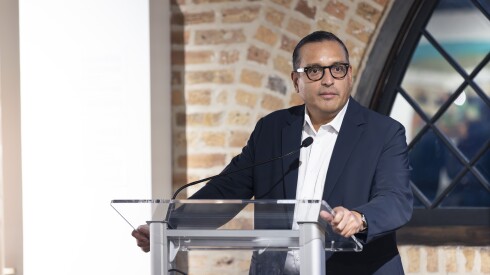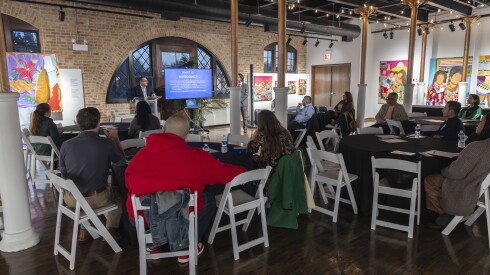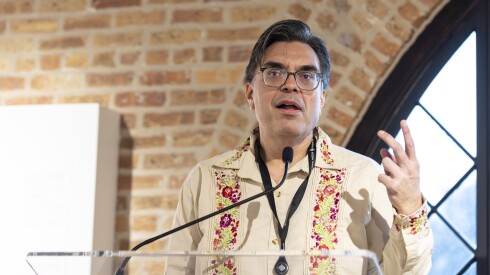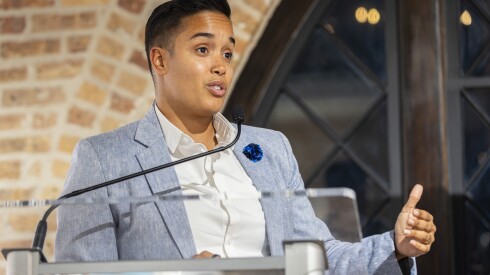In July, a swarm of unmarked cars bearing agents from the Department of Homeland Security suddenly appeared in the lot of the National Museum of Puerto Rican Art and Culture in Humboldt Park.
Local elected officials and community members called the visit a scare tactic; President Donald Trump’s officials said they’d been staging an operation related to a narcotics investigation.
But the agents’ presence outside a Chicago cultural institution sparked a panic that spread across city museums and event spaces as they weighed how to protect their staff and audiences.
On Friday, a group of museum leaders met for a two-hour training at the Puerto Rican museum hosted by the nonprofit Latinos Progresando. While reports indicate that senior U.S. Border Patrol official Greg Bovino left Chicago last week, with plans to scale back the number of federal immigration agents in the city throughout the winter, a source with the Homeland Security department has signaled that 1,000 agents could return in March.
Latinos Progresando said it is seizing the opportunity now to train event organizers and museum leaders. “Although there may be a little bit of a sigh of relief, I think it’s very important that we take this opportunity to prepare ourselves for what’s coming,” said Luis Gutiérrez, founder of Latinos Progresando.
That’s what drove just under two dozen representatives from the Shedd Aquarium, Lincoln Park Zoo, Chicago History Museum, Chicago Park District and other organizations to attend the Friday workshop, where they received advice such as appointing a designated representative onsite to deal with agents.
Homero Tristan, a founding partner at Tristan & Cervantes, told the group it’s rare for ICE to get warrants signed by judges to carry out immigration enforcement. However, all cultural institutions should familiarize themselves with I-9 audits, he said: They are used to verify whether an individual is authorized to work in the U.S.
Thomas Henkey, who works as VP of emergency management at Marksman-Titan Security Group in Downtown Chicago, said he attended the training on behalf of his organization.
Marksman-Titan provides security to various institutions across a large part of Chicago’s cultural and nonprofit sectors — many of which were also in the room on Friday.
“We have an ethical and moral obligation to protect people and property. That’s why we do what we do,” Henkey said.
Security professionals at museums, theaters and similar places are most likely to be the first point of contact with ICE agents, he said. Consequently, clients of Marksman-Titan have approached Henkey and his colleagues to ask: ‘“Hey, what is security going to do if ICE shows up at our building?’”
Henkey said he’d be going back to his colleagues and clients to share all that he learned at the Friday workshop. And the organizations that Marksman-Titan works with have been resilient to challenges of the last five years, he said.
“These folks have been through the pandemic. They’ve been through massive funding cuts. They’ve been through staffing challenges,” he said. “When they get punched, they get back up again.”
The National Museum of Mexican Art in Pilsen, a co-host of Friday’s workshop, experienced its own scare with federal agents earlier this year, according to José Ochoa, the museum’s president and CEO.
On July 3, an agent with the U.S. Marshals Service entered the Pilsen museum, he said. Ochoa considers that visit an “unwelcome dress rehearsal” for what was to come. After that incident, the museum implemented strict guidelines, including clearly marked badges for all employees and a prepared response for federal agents.
“But the goal line keeps moving,” he said, referring to the constantly changing political landscape, which makes it hard to stay up-to-date with the correct information. “We’re definitely stronger, we’re definitely more organized, we’re definitely more knowledgeable, but the situation is going to continue to change.”
Ochoa said the NMMA hasn’t seen a decline in attendees since “Operation Midway Blitz” kicked off in September — in fact, it’s been the “opposite,” he said. More allies have come out to support the museum, but there have been fewer visits by undocumented neighbors.
Ochoa likened the cultural groups’ preparedness to active shooter drills that take place in most schools across the country. When something happens, all kids “know what to do,” he said. “It’s in their bodies, because they practice it all the time. And I realized [when the U.S. Marshal showed up] that we had not practiced.”
Speakers also included Ald. Jessie Fuentes (26th), who was handcuffed by federal agents in October at a Humboldt Park hospital after asking officers to show a warrant. The detainment was caught on video and shared widely.
“What we are watching right now, in this moment in our country,” she warned the museum leaders, “is racism turned into policy.”



